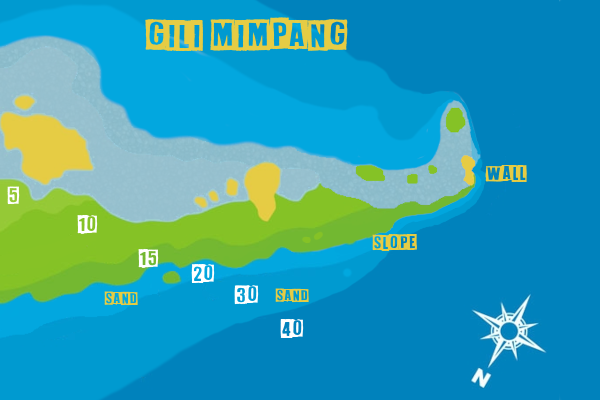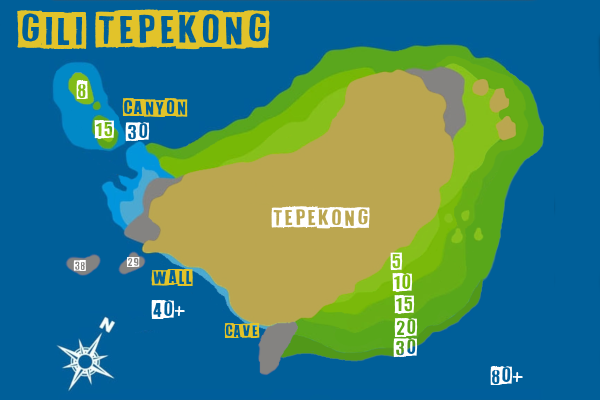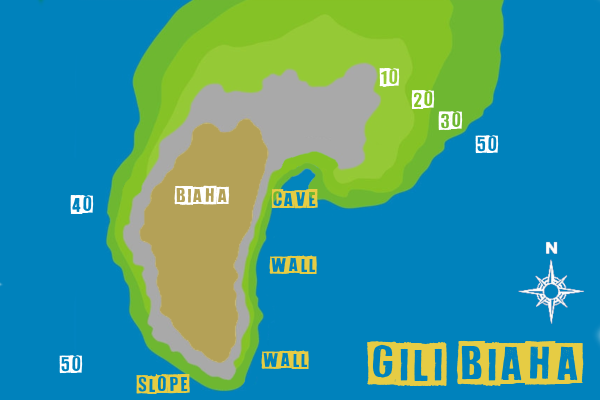Diving Gili Mimpang, Tepekong & Biaha
Bali’s Wild Side
Gili Mimpang & Tepekong – Diving Spots, Dive Sites Map
Gili Mimpang & Tepekong – Diving Spots, Dive Sites Map
Welcome to one of Bali’s most thrilling dive areas, located off the coast of Amuk Bay in front of Candi dasa near Padang Bai. The trio of volcanic islets known as Gili Mimpang, Gili Tepekong, and Gili Biaha is famous for its dramatic underwater topography, strong currents, and the chance to see big pelagics like sharks, tunas, barracuda, and even Mola Mola during the right season.
These dive sites are not for beginners — but for experienced divers seeking adventure, this is Bali diving at its most exciting. From steep walls, caves, and swim-throughs, to adrenaline-pumping drifts and rare marine life, this region offers some of the most dynamic diving you’ll find anywhere in Indonesia.
At Bali Aqua Dive Center, we organize guided trips to Mimpang, Tepekong, and Biaha with strict safety protocols, experienced instructors, and small groups only. When conditions are good, these sites are unforgettable — and often become a diver’s favorite in Bali.
Diving Experience Requirements!
Diving at Gili Mimpang, Tepekong, and Biaha requires at least an Advanced Open Water certification or equivalent experience. These sites are known for unpredictable currents, surge, and sometimes down currents, especially around Tepekong and Biaha. We recommend these dives only for experienced divers who are confident in drift diving and maintaining good buoyancy control. If you’re unsure whether these sites are right for you, we’re happy to recommend safer alternatives nearby at Padang Bai — or help you upgrade your skills before visiting these spectacular dive spots.
These three islets are the wild side of Bali diving — places where nature still reigns. The area is part of the Indonesian Throughflow, bringing cooler, nutrient-rich currents that feed vibrant coral walls and attract larger marine life.
Here’s why these sites are a must for serious divers:

Just a 30-minute ride on a traditional jukung boat from Padang Bai, Gili Mimpang is the first of the three islets in this powerful dive zone, and it’s often considered the most accessible of the trio. Made up of three rocky outcrops breaking the surface of the water, this dive site offers a mix of dramatic topography, healthy reef, and pelagic surprises — all with a dose of adrenaline depending on current strength.
The dive at Gili Mimpang usually begins from the north side, directly in front of the middle islet, where we descend over a sandy bottom. This strategic entry gives divers time to reach the right depth before encountering the shallower channel between the rocky outcrops. From there, we head toward a gentle sandy slope where white tip reef sharks often rest, and a cleaning station sometimes visited by Mola Mola during the right season.
As the dive progresses, we drift toward the southernmost islet, where the topography becomes more dramatic with a steep wall — an ideal lookout for spotting oceanic sunfish ascending from deeper water between July and October. Careful navigation is required here to avoid being swept into the blue by strong outward currents.
Toward the end of the dive, as air levels drop, we ascend toward the southeastern shallow channel between the islets. This section features large boulders with cracks and overhangs, creating hiding spots for juvenile sharks, schooling sweetlips, snapper, and the occasional Napoleon wrasse cruising the reef. It’s a fantastic final section for reef life and relaxing after the earlier excitement.
Mimpang’s conditions can vary — from a gentle drift to stronger currents depending on tide and swell. Our dive guides always evaluate the entry time to choose the safest window, and this site is only dived with experienced divers in small guided groups.
Thanks to its vibrant corals and fish density, Mimpang is also a fantastic wide-angle site for underwater photographers — especially in the early morning when the sun cuts beautifully across the reef ridges.

Type of Dive: Boat dive, wall, surge, canyon
Depth: 10–40+ meters
Visibility: 15–30 meters (can drop during surge)
Temperature: 19°C to 28°C (cold thermoclines common)
Conditions: Moderate to very strong current, downcurrent risk in canyon, big surge.
Marine Highlights: Shark nursery, swim-throughs, pelagics, trevally, frogfish, Mola Mola (seasonal)
Recommended Level: Advanced Open Water or higher; excellent buoyancy & current management, canyon dive for highly experienced only
Macro Level: ⭐⭐☆☆☆☆
Wide Angle: ⭐⭐⭐⭐☆☆
Gili Tepekong is one of Bali’s most thrilling dive sites and also one that demands respect, precision, and experience. This small volcanic island off Candi dasa near Padang Bai rises dramatically above the surface and plunges steeply into the depths below. Its powerful currents, impressive walls, and surge-filled swim-throughs make it a must-dive location for experienced adventurers.
Often described as Bali’s most intense diving experience, Tepekong features a mix of lava rock canyons, pelagic sightings, and rare shark encounters, making it one of the top adrenaline dives in Indonesia.
Route 1: The South Wall & Shark Boulder (Common Dive Plan)
This is the most commonly dived route, ideal when moderate conditions prevail. We usually begin on the southwest wall, descending alongside a dramatic drop-off and reaching a swim-through tunnel that connects 28 meters to 18 meters — a stunning start with wide-angle appeal.
From there, the dive drifts gently eastward along a sloping reef, where large pelagic species like trevally or even tuna might appear in the blue. The highlight of this section is the famous “shark nursery” — a massive boulder in the shallows where white tip reef sharks often rest beneath, offering an exciting yet safe observation point.
As we reach the shallowest zone, the reef bursts with colorful corals, vibrant schooling fish, and a second swim-through, just a few meters below the surface. Be aware: strong surge is common in this final section, adding an extra element of fun (and challenge) before a gentle drift during the safety stop.
Route 2: The Canyon (Advanced-Only Dive)
The second dive route at Tepekong leads into the infamous Canyon — a deep crack between two towering rock formations on the north and east side. This dive is only conducted when ocean conditions are exceptionally calm, as the Canyon is known for strong vertical currents and the risk of down currents, making it suitable only for experienced divers with excellent control and accompanied by our most senior guides.
When it’s safe, the Canyon reveals an awe-inspiring lava rock formation, shark sightings, and the chance for unexpected big fish encounters in the shadows of the crack.

Type of Dive: Boat dive, wall, surge, canyon
Depth: 10–40+ meters
Visibility: 15–30 meters (can drop during surge)
Temperature: 19°C to 28°C (cold thermoclines common)
Conditions: Moderate to very strong current, downcurrent risk in canyon, big surge.
Marine Highlights: Shark nursery, swim-throughs, pelagics, trevally, frogfish, Mola Mola (seasonal)
Recommended Level: Advanced Open Water or higher; excellent buoyancy & current management, canyon dive for highly experienced only
Macro Level: ⭐⭐☆☆☆☆
Wide Angle: ⭐⭐⭐⭐☆☆
Remote, rugged, and shaped like a half-moon, Gili Biaha lies farthest from shore among the three Amuk Bay islets — and is the wildest of them all. This site is often reserved for the final dive of a full-day trip, and offers something few places in Bali can: a chance to peek inside an underwater shark cave, surrounded by rich reef life and backdropped by dramatic volcanic rock formations.
The main highlight at Biaha is the shark cave, located on the northeastern side of the island at around 10–12 meters deep. This wide entrance in the reef wall is often home to resting white tip reef sharks, offering an unforgettable opportunity to observe them up close in their natural shelter.
When swell hits the island, it creates a distinct pressure surge that flows into the cave. Divers can feel a brief compression in their chest or rib cage with each pulse — a harmless but very noticeable sensation. Masks air volume are also affected with a brief squizz. The sudden pressure changes can sometimes confuse dive computers too, causing them to log a temporary ascent rate alert or even assign short deco penalties due to the perceived pressure fluctuation.
Once inside, the cave offers an eerie, calm atmosphere, with enough room to hover gently and watch the sharks from a respectful distance. It’s an advanced and memorable dive moment — best enjoyed with perfect buoyancy, calm breathing, and a steady awareness of surge patterns.
After exiting the shark cave, we typically head south, following the deep outer wall at around 20 to 25 meters. This section is sculpted by lava formations that resemble columns and vertical pillars, creating an otherworldly terrain. Even at depth, the surge can still be felt strongly, adding a dramatic rhythm to the dive.
Midway along the wall, we reach a wide indentation — a natural resting zone where we can pause, check air, and scan for hidden critters like frogfish or octopus nestled in the cracks. If conditions and air allow, we continue toward the southern tip of the island, where currents converge and marine life thrives. This area can deliver spectacular encounters — including sharks, rays, and Mola Mola during the right season.
The return route follows the shallower upper section of the wall, where a terrace-like “step” formation hosts more vibrant coral, reef fish, and macro life. This natural ledge is ideal for a relaxing safety stop, often with smaller sharks anthias, schooling fusiliers, or morays waving from their hideouts.
These sites can be dived year-round, but some periods offer better conditions depending on your goals and experience level.
Dry Season (April to October)
Wet Season (November to March)
Gili Mimpang, Tepekong, and Biaha offer some of the most exhilarating dive sites in Bali — with rugged topography, thrilling currents, and unforgettable encounters with sharks, pelagics, and seasonal Mola Mola.
Whether you’re an experienced diver looking for a new challenge or building a multi-day dive trip around Bali, our team at Bali Aqua Dive Center will make sure every detail is taken care of — from scheduling and logistics to safe, expertly guided dives.
Contact us now to plan your dive at Mimpang, Tepekong, or Biaha — or explore our Dive Packages and Best of Bali packages, Diving Safaris to include them in a bigger adventure!